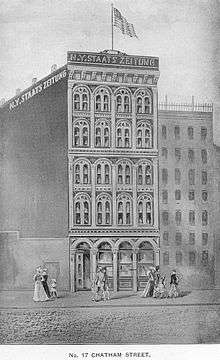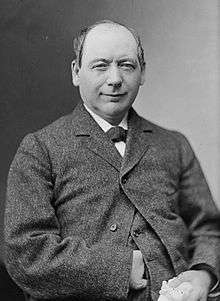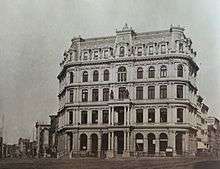New Yorker Staats-Zeitung
 Staats-Zeitung Building, 1857-1873 | |
| Type | Weekly newspaper |
|---|---|
| Owner(s) | Jes Rau |
| Founded | 1834 |
| Language | German |
| Headquarters | Sarasota, Florida |
| ISSN | 1542-1465 |
| Website | http://www.germancorner.com/NYStaatsZ/ |


.jpg)


The New Yorker Staats-Zeitung, nicknamed "The Staats", claims to be the leading German-language weekly newspaper in the United States.[1] It is certainly one of the oldest, having been published since the mid-1830s. In the late 1800s it was one of New York City's major daily newspapers, exceeded in circulation only by the New York World and the New York Tribune.[2] Among other achievements, as of its sesquicentennial anniversary in 1984 it had never missed a publication date, thereby laying claim to the title of being continuously published longer than any other newspaper (of any language) in America.[3]
History
The Staats-Zeitung was founded in New York City in 1834 by a society of German-American businessmen.[4] The partners included George Zahm, Stepan Molitor, Conrad Braeker, and Gustav Adolph Neumann, with Neumann serving as editor-in-chief (as well as reporter and production foreman). Neumann subsequently purchased shares of the enterprise until, in the late 1830s, he obtained a majority, after which the society was dissolved and he became sole owner.
The first issue was published on December 24, 1834. The nascent newspaper consisted of four pages and was printed weekly using a Washington hand-press. Initial circulation was small, limited by the capacity of the press (2000 impressions per day) and by the size of the audience (primarily German immigrants). At that time there were approximately 10,000 German-born citizens in New York City.
Growth during the first few years of the paper's existence was also impeded by the Financial Panic of 1837, but by 1839 it was sufficiently successful to move to a location on Frankfort Street, a few blocks from City Hall. Under Neumann's guidance, improvements to the physical plant were undertaken to support the growth that accompanied its increasing influence. In 1843, on obtaining a single cylinder hand-operated press that could print 600 sheets per hour, he converted the Staats-Zeitung to a tri-weekly publication.[4]
The paper's staff also expanded as it grew. Notable additions included: Jacob Uhl, who may have been hired as a printer as early as 1836;[2] Jacob's wife Anna Uhl, who worked as a compositor, secretary, and business manager;[5] and Oswald Ottendorfer, who appears to have been hired in the counting room in 1850.[2] All had a role to play in the unfolding story.
In 1845 Jacob Uhl bought ownership and publishing rights from Neumann who, nonetheless, continued in an editorial capacity until 1853. Working together, Jacob and Anna Uhl increased both advertising patronage and circulation, enabling a shift to daily publication not long after the purchase.[4] Subsequently, the paper's physical plant was moved to and combined with a printing office owned by Jacob Uhl, and a Sunday edition was added on January 3, 1848. The enhanced paper quickly outgrew both the press capabilities and the physical space of the printing office, and in 1850 Uhl purchased property specifically to house the Staats-Zeitung'". He installed the most rapid printing presses then available in a new building erected on the property for that purpose.[4]
When Jacob Uhl died in 1852, Anna Uhl took over management of the newspaper. The paper continued to thrive, and by 1857 another expansion was required. Anna Uhl purchased property on what was then Chatham Street (also known at that time as"Newspaper Row", now Park Row) and had a suitable building erected (pictured above). One of the first rotary type-revolving presses was installed, increasing the publishing capacity to 4,000 papers per hour.[4]
In 1858, Anna Uhl appointed Oswald Ottendorfer - who had gradually been contributing more assistance - as editor. In 1859 Anna Uhl and Oswald Ottendorfer were married, and continued to operate the paper together, with Oswald serving as editor and publisher while Anna functioned as business manager. In 1873 another expansion was completed under the German-American architect J. William Schickel at 17 Chatham Street (pictured below). Anna Ottendorfer continued as business manager until shortly before her death in 1884 when her son Edward Uhl[6] succeeded her. Together Anna and Oswald Ottendorfer developed the Staats-Zeitung into a major newspaper. By the 1870s, its circulation was comparable to English-language newspapers like the New York Tribune and the New York Times.[7]
In 1879, the property of the paper was changed into a stock company.[8] When Oswald Ottendorfer died in 1900, the newspaper was sold to Herman Ridder, who had become manager and trustee in 1890.[9] Ridder went on to contribute to the foundation of the Knight Ridder conglomerate, and the Staats-Zeitung gradually became a side line. It stayed in the Ridder family until 1953, when it was sold to the Steuer family who changed from a daily newspaper to three times a week and finally a weekly. In 1989, it was sold to Jes Rau.
From 1968 to 1969, the German entertainer and comedian Herbert Feuerstein was editor-in-chief of the newspaper.
Political influence
The German-American businessmen who founded the New Yorker Staats-Zeitung in 1834 did so with a specific agenda in mind. The paper was to be the voice of German-Americans who opposed the Whig Party, then the dominant political force in New York City.[4] This stance aligned the paper with the objectives of the Jacksonian Democrats, who were at that time developing the Tammany Hall political machine. Mr. Neumann's editorials took forceful and animated positions in support of the interests of German-American immigrants who sought to become full participants in the governance of their new home.[4]
However, the paper was also concerned with events in Europe, undoubtedly because German immigration at this time was often motivated by political repression in Germany. Jacob Uhl, for example, is said to have left Germany a year or two after being jailed for participating in a democratic riot in Frankfurt.[2] As owner of the paper, he supported the German Revolution of 1848. Oswald Ottendorfer was an active participant in those European uprisings - in 1848 in Vienna and in 1849 in Saxony. His passion for things political remained after he immigrated to America, and he continued to develop the political clout of the Staats-Zeitung after he became editor in 1858.[4]
From 1860 to 1864, Franz Umbscheiden - who also participated in the German Revolution of 1848 - was on the staff.[10]
During World War II, the paper had an evolving view of Adolf Hitler and the Third Reich. In 1934, the Staats-Zeitung opposed the "mock trial" of Hitler to be held at Madison Square Garden, calling Nazi Germany a "friendly nation" and asking the U.S. to respect "the laws and deeds of the statutory regime of the German Reich; the laws and deeds of the lawful administration of government of a friendly power.[11] A year earlier, however, the paper published an editorial, entitled "Blind Fanatism" and signed by its then editor, Benjamin F. Ridder, denouncing the Nazi persecution of Jews.[12] Later, the paper revealed a strongly anti-Nazi position, publishing many anti-Nazi editorials and articles, until Nazi party member Heinz Spanknöbel storm the paper's office and forced the editors to write Nazi-sympathetic articles.
Current status
The newspaper aims to promote historical awareness, inform about current events and encourage critical thinking about German-American relationships.
See also
- Anzeiger des Westens, the German-language daily paper in St. Louis founded one year later, that became the largest newspaper of any language in the state
- Carl Eytel, an early 20th-century German-American artist living in Palm Springs, California, who contributed to the newspaper over a 14-year period[13]
References
- ↑ For example, on the Staats-Zeitung website.
- 1 2 3 4 "History of a New York City Institution", retrieved from the Staats-Zeitung web site on April 15, 2012. The information provided on this web page is not referenced to primary sources and sometimes conflicts in details (such as dates or spellings) with known reliable sources.
- ↑ Page B-2, New Yorker Staats Zeitung, 17/18 November 1984. Sonderbeilage Der New Yorker Staats-Zeitung Und Herold: 1834-1984. 150 Jahre New Yorker Staats-Zeitung. (150th Anniversary Commemorative Supplement)
- 1 2 3 4 5 6 7 8 An Epitome of the New-Yorker Staats-Zeitung's Sixty-Five Years of Progress. 1899. Complimentary pamphlet prepared and distributed by the Staats-Zeitung to describe its history and new press capacity.
- ↑ Edwin H. Zeydel (1928–1990). "Ottendorfer, Anna Behr Uhl". Dictionary of American Biography. VII, Part 2. New York: Charles Scribner's Sons. pp. 106–107.
- ↑ A short biography of Edward Uhl is available in German at: de:Edward Uhl
- ↑ James M. Bergquist (1999). "Ottendorfer, Anna Behr Uhl". American National Biography. 16. New York: Oxford University Press. pp. 841–842.
- ↑ Sarah Knowles Bolton (1896). Famous givers and their gifts. p. 329.
- ↑
 Reynolds, Francis J., ed. (1921). "Ridder, Herman". Collier's New Encyclopedia. New York: P.F. Collier & Son Company.
Reynolds, Francis J., ed. (1921). "Ridder, Herman". Collier's New Encyclopedia. New York: P.F. Collier & Son Company. - ↑ Carl Wittke (1952). Refugees of Revolution: The German Forty-Eighters in America. Philadelphia: University of Pennsylvania Press. p. 270.
- ↑ "Expect Crowded Courtroom at Hitler 'trial' Tomorrow". JTA. March 6, 1934. Retrieved 8 October 2015.
- ↑ Beck, Alfred M. Hitler’s Ambivalent Attaché. Potomac Books. p. 327.
- ↑ Law, George (January 28, 1923). "Desert Painter: Carl Eytel". Los Angeles Times. Los Angeles, CA. p. X17 (Illustrated Magazine). ISSN 0458-3035.
...in a role of raconteur unbeknown to his friends, [he] was regularly contributing illustrated articles...telling the York State Germans and the subscribers in all parts of the world about his long journeys and adventures....
(subscription required)
Further reading
-
 Wilson, James Grant; Fiske, John, eds. (1900). "Ottendorfer, Oswald". Appletons' Cyclopædia of American Biography. New York: D. Appleton.
Wilson, James Grant; Fiske, John, eds. (1900). "Ottendorfer, Oswald". Appletons' Cyclopædia of American Biography. New York: D. Appleton. - Karl J. R. Arndt and May E. Olson, The German Language Press of the Americas, Volume I: "History and Bibliography, 1732 to 1955", 3rd revised edition, 1976.
- Carl Wittke, The German Language Press in America, 1957.
- Obituary of Anna Ottendorfer at The New York Times. This source disagrees substantially with the Zeydel and Bergquist biographies on Anna Ottendorfer's maiden name and when she and Jacob Uhl arrived in America.
External links
- Official website
- History of a New York City institution (at the Staats-Zeitung website)
- Historical Newspapers, Germany